|
|
|
| Sapphires from Andranondambo, discovered in 1991. ( South-Eastern Madagascar )
  
|
In 1658, Flacourt, the governor of Fort-Dauphin, mentions
|
| sapphires in southern Madagascar. |
| In 1808, Barthélemy Hugon writes that in the valley of |
| Ambolo there is a so beautiful stone and so rare that his |
| lapidaries have not been able to recognize it and it was |
| above of all that is not diamond. ... In 1991, at the time of |
| the great dryness in the south, sapphire samples are found, |
| several centuries after their first discovery. The son of Mrs. |
| Dauphine, innkeeper in Tranomaro, main village of the |
| valley, was among the prospectors. |
| Actually, one of the most beautiful sapphire quality in the |
| world is just leaving ground. |
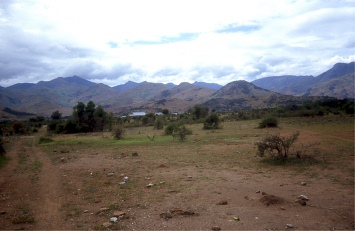 |
 |
The Tranomaro area is characterized by an |
| extreme calcic and magnesian paragneiss abundance: |
| Gneiss with diopside, plagioclasites, pyroxenites, |
| wernerites, wolastonite marble, with varied |
| leptynites, generally with garnet, kinzigites, quarzites. |
| One finds there rather frequently syenitic gneisses |
| or lamboanites. Gneisses of injection are very |
| frequent. |
| The typomorphic minerals are: basic diopside, |
| scapolite, calcite, plagioclases, |
| wollastonite, garnet, cordierite and corundum. |
| East of Tranomaro, arteritic and eyesys injections |
| assign gneisses at leptynites. Cordierite gneiss stripes |
| are deeply injected bed by bed, the injection has |
| introduced magnetite in abundance. |
| Wollastonites form ptymatic lenses with |
 |
Marohotro, 8 km. south of Andanondambo. |
folds very tortured at the middle of the limestone. |
| The sapphire on the left comes from Ambandanira, and |
Note:aluminous anorthites or sakenites. |
| that on right-hand side from Maromby |
|
| (area of Andranondambo) |
|
|
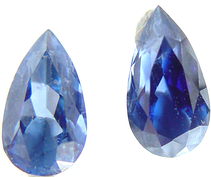 |
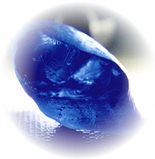 |
|
|
| -------------------------------------------------------------------------------------------------------------------------------------- |
|
|
|
|
|
|
|
|
|
|
Holes can reach 20 meters depth. |
|
|
|
|
| Sapphires from Ilakaka. |
One of the various holes in sandstone forming |
| ( South-Western Madagascar ) |
the deposit of Ilakaka discovered in to 1998. |
|
|
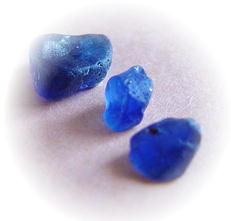 |
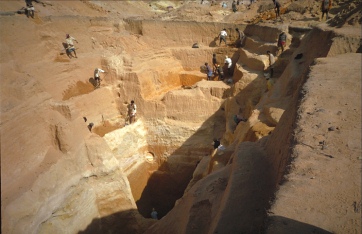 |
| Blue sapphires , pink and violet, Ilakaka area. |
|
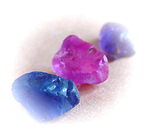 |
ISALO SANDSTONES. |
| The white sandstones of Isalo present imposing |
| stratifications intersected with gravel beds and |
| small conglomerates. |
| These soft sandstones resisted to erosion and taken a |
| ruiniform relief because the presence of braces siliceous |
| veins. |
| The mineral-bearing deposits include : a deposit of generally |
| classified gravels, the richest part and larger elements |
| being at the base of the bed - rock. |
| -------------------------------------------------------------------------------------------------------------------------------------- |
|
The far-south of Madagascar, semi-desert, does not present |
 Polychrome sapphires from Iankaroka Polychrome sapphires from Iankaroka |
| any asphalt road yet, dust and trepidations are the daily |
| discovered in 1990. |
lot of any traveller. Sunsets and the natural life of its |
|
inhabitants offer an appreciable compensation. |
|
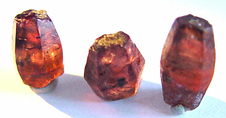 |
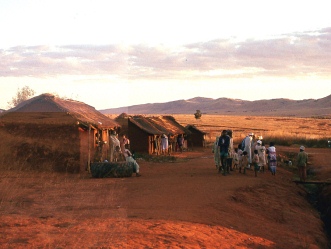 |
|
|
|
|
|
|
| This sapphire occur in a contact |
| zone between granites and |
| migmatites. |
|
| It is found in its bedrock. |
|
|
|
|
|
|
|
|
|
|
|
 Rubies from Ianavoha. Rubies from Ianavoha. |
|
| (Southern Madagascar.) |
|
|
|
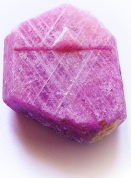 |
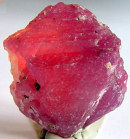 |
|
|
|
 |
|
Rubies in syenite from Andranomilitsy. |
|
|
|
 Ruby from Andranomilitsy (Vohitany) Ruby from Andranomilitsy (Vohitany) |
Syenitic-nephelinic vein of rubies in Andranomilitsy. |
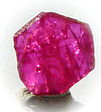 |
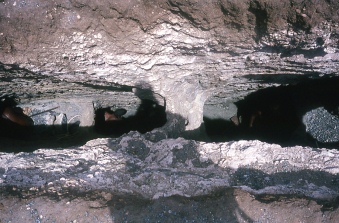 |
| -------------------------------------------------------------------------------------------------------------------------------------- |
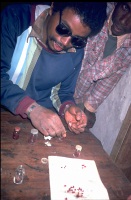 |
In Soamiakatra, rubies were sold with sunglasses. |
The Mayor of Soamiakatra in 1989, (East of Antsirabe.)
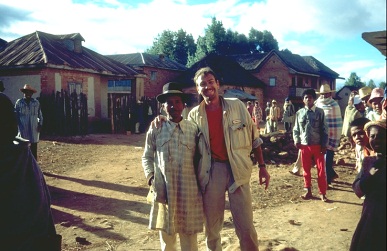
 Rubies from Soamiakatra in the highlands. Rubies from Soamiakatra in the highlands.
Here, rubies are always found in alluvium.
MADAGASCAN CORUNDUMS
|
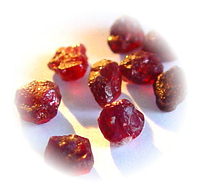  |
| -------------------------------------------------------------------------------------------------------------------------------------- |
| Ambondromifehy ( Diego ) |
|
| BLUE SAPPHIRE NATURAL COLOR |
 |
|
| Sapphire from Analafady (Ambondromifehy) North. |
|
|
|
 |
|
| The Ambondromifehy alluvial deposit is exploited since |
| 1996. It is located in a Jurassic limestone, but the origin of |
| sapphires is in alkaline basalts from the close volcanic zone. |
|
|
 |
Mahatsara ( Ambondromifehy) |
|
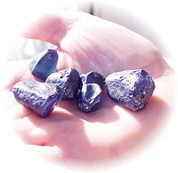 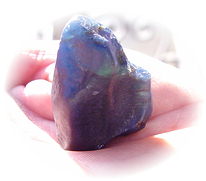
|
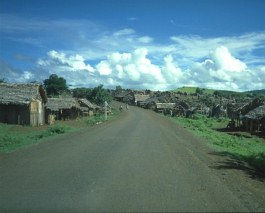 |
|
|
|
|
|
The consumption of khat “a kind of narcotic plant” is quite
|
|
|
common in the Diego-Suarez region, people can be very
|
|
| dynamic. |
|
|
|
| This deposit produced mainly blue sapphires, but also some |
|
| bi-color, some yellow sapphires, and rough material to cut in |
|
| cabochon and, star sapphire too. |
|
|
|
|
|
|
|
|
|
|
|
|
|
|
|
|
|
|
|
| ------------------------------------------------------------------------------------------------------------------------------------- |
| Didy Sapphire & Ruby Rush 2012 |
|
|
|
|
| Within 2011, sapphires from Ambatovolana reached |
|
| the capital Antananarivo sporadically, brought there |
| by gold miners. |
|
|
| Ambatovolana is located 25 kilometers south-east of |
| the village of Didy, which is located 45 km.south-east |
| from the town of Ambatondrazaka. (Tamatave region.) |
|
|
| On July 18th 2011, a lapidary from the Capital reveals to |
| me that the extraordinary sapphires in his hand come |
| from "Ivoloina" a new deposit located in the region of |
| Brickaville, on the road to the port of Tamatave |
| (Toamasina.) I buy the stones. |
| But it was not the truth. |
|
| " The deposit on the Ivoloina river is actually located 40 |
| kilometers from Tamatave." |
|
|
|
|
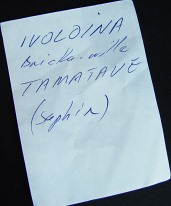 |
|
|
|
|
|
In the beginning of 2012, a sapphire and ruby rush occurred |
|
due to the exceptional color, clarity and size of the precious |
|
stones found there. |
|
|
|
Discovered in alluvium, in the core of a wild forest, sapphires |
|
and rubies required holes from 50 centimeters to 2 meters |
|
depth only to be extracted. |
| |
|
|
|
| Paper written by the cutter. |
|
|
|
|
| Alaotra formations: |
|
|
|
|
|
| Crystalline schists: |
|
|
| The petrographic bottom is characterized by an abundance of pyroxéno- |
|
| amphibolic formations in a set in which gneissico-migmatitic rocks are |
|
| found as follows: |
|
| - The gneisses at hypersthene are well represented on the North and |
|
| East bank of Lake Alaotra: |
|
| - Amphibolites and shale feldspathics pyroxenites appearing frequently in |
|
| patches or enclaves to form heterogeneous migmatites of épibolites type |
|
| (rocks consist of interbedded veins of aplites beds per bed). |
|
| - The amphibole gneiss, amphibole and biotite, or biotite alone can pass |
|
| locally to banded migmatites. |
|
| - Locally surmicaceous gneiss and mica becoming micaschists and containing |
|
| shreds of muscovite mica schists between the rivers Onibe and Ivondro. |
|
| - Finally, beds of quartzite or magnetite quartzite distributed of very irregular |
|
| manner : magnetite quartzites show a bigger development in the region of |
|
| Imerimandroso and Andilamena peninsula, on the shores of Lake Alaotra; |
|
| white quartzites more or less crystallized are quite rare and form thin beds. |
|
| We can distinguish an aluminous series and calco-magnesian series. |
|
| Alumino-silicate series is not uniformly distributed, but appears quite clearly |
|
| located at the base of the group Alaotra. This series is represented by |
|
| sillimanite quartzites and gneisses more or less quartzic biotite, sillimanite |
|
| and garnet, very often these gneiss are graphitic. |
|
| Calc-magnesian series develops on the western bank of the group Alaotra, |
|
| especially south of Ambatondrazaka where diopside gneisses and marbles |
|
| are of great importance. |
|
|
|
| - Gabros have a significant development in the group Alaotra, their |
|
| main feature is their perfect match with the surrounding formations. |
|
|
|
|
|
|
| |
©  All of the pictures on this website have been shot by gggems.com All of the pictures on this website have been shot by gggems.com |
Your guide to GGGems |
 |
| Text written by Alain Darbellay. |
Alain Darbellay |
| |
|
|